| Listing 1 - 8 of 8 |
Sort by
|
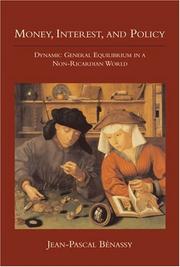
ISBN: 0262026139 9780262026130 0262524937 9786612097003 0262268086 1282097008 1429465530 9780262268080 9781429465533 9781282097001 6612097000 9780262524933 Year: 2007 Publisher: Cambridge, Mass. : MIT Press,
Abstract | Keywords | Export | Availability | Bookmark
 Loading...
Loading...Choose an application
- Reference Manager
- EndNote
- RefWorks (Direct export to RefWorks)
An important recent advance in macroeconomics is the development of dynamic stochastic general equilibrium (DSGE) macromodels. The use of DSGE models to study monetary policy, however, has led to paradoxical and puzzling results on a number of central monetary issues including price determinacy and liquidity effects. In Money, Interest, and Policy, Jean-Pascal Benassy argues that moving from the standard DSGE models - which he calls "Ricardian" because they have the famous "Ricardian equivalence" property-to another, "non-Ricardian" model would resolve many of these issues. A Ricardian model represents a household as a homogeneous family of infinitely lived individuals, and Benassy demonstrates that a single modification-the assumption that new agents are born over time (which makes the model non-Ricardian)-can bridge the current gap between monetary intuitions and facts, on one hand, and rigorous modeling, on the other.After comparing Ricardian and non-Ricardian models, Benassy introduces a model that synthesizes the two approaches, incorporating both infinite lives and the birth of new agents. Using this model, he considers a number of issues in monetary policy, including liquidity effects, interest rate rules and price determinacy, global determinacy, the Taylor principle, and the fiscal theory of the price level. Finally, using a simple overlapping generations model, he analyzes optimal monetary and fiscal policies, with a special emphasis on optimal interest rate rules.
Money --- Equilibrium (Economics) --- Mathematical models --- AA / International- internationaal --- 305.7 --- 333.80 --- -Equilibrium (Economics) --- -339.53 --- Currency --- Monetary question --- Money, Primitive --- Specie --- Standard of value --- Exchange --- Finance --- Value --- Banks and banking --- Coinage --- Currency question --- Gold --- Silver --- Silver question --- Wealth --- Econometrie van het gedrag van de financiële tussenpersonen. Monetaire econometrische modellen. Monetaire agregaten. vraag voor geld. Krediet. Rente. --- Geld-, bank- en kredietpolitiek. Kapitaalmarkt en -rente: algemeenheden. --- Mathematical models. --- ECONOMICS/Political Economy --- ECONOMICS/Macroeconomics --- 339.53 --- Econometrie van het gedrag van de financiële tussenpersonen. Monetaire econometrische modellen. Monetaire agregaten. vraag voor geld. Krediet. Rente --- Geld-, bank- en kredietpolitiek. Kapitaalmarkt en -rente: algemeenheden --- Money - Mathematical models --- Equilibrium (Economics) - Mathematical models
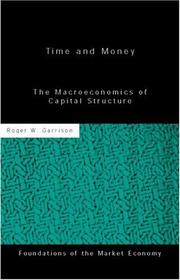
ISBN: 0415079829 0415771226 9786610324255 0203208080 1280324252 0203320387 0429229690 1134895909 9780203320389 9780415079822 9780203208083 6610324255 9781134895908 9781134895854 1134895852 9781134895892 1134895895 9780415771221 9780429229695 9781280324253 Year: 2002 Publisher: London : Routledge,
Abstract | Keywords | Export | Availability | Bookmark
 Loading...
Loading...Choose an application
- Reference Manager
- EndNote
- RefWorks (Direct export to RefWorks)
Time and Money argues persuasively that the troubles which characterise modern capital-intensive economies, particularly the episodes of boom and bust, may best be analysed with the aid of a capital-based macroeconomics. The primary focus of this text is the intertemporal structure of capital, an area that until now has been neglected in favour of labour and money-based macroeconomics.
Money --- Capital --- Macroeconomics --- 339.53 --- Economics --- Capital assets --- Fixed assets --- Capitalism --- Infrastructure (Economics) --- Wealth --- Currency --- Monetary question --- Money, Primitive --- Specie --- Standard of value --- Exchange --- Finance --- Value --- Banks and banking --- Coinage --- Currency question --- Gold --- Silver --- Silver question --- Money. --- Capital. --- Macroeconomics. --- E-books
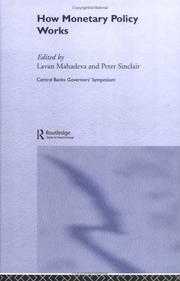
ISBN: 0415343518 0415648378 9786610290543 1134289847 1280290544 0203324137 9780203324134 9780415343510 6610290547 9780415648370 9781134289844 9781280290541 9781134289790 9781134289837 Year: 2005 Publisher: London ; New York : Routledge,
Abstract | Keywords | Export | Availability | Bookmark
 Loading...
Loading...Choose an application
- Reference Manager
- EndNote
- RefWorks (Direct export to RefWorks)
For monetary policymakers worldwide, developing a practical understanding of how monetary policy transmits to the economy is a day-to-day challenge. The data such policymakers have is imperfect, the maps they use are continually redrawn. With such uncertainty, understanding this complicated issue is rarely straightforward.This book, a collaboration between some of the finest minds working on monetary theory in the world, helps to provide a foundation for understanding monetary policy in all its complex glory. Using models, case studies and new empirical evidence, the contributors to this b
AA / International- internationaal --- 333.80 --- Monetary policy --- 339.53 --- Monetary management --- Economic policy --- Currency boards --- Money supply --- Geld-, bank- en kredietpolitiek. Kapitaalmarkt en -rente: algemeenheden. --- Monetary policy. --- Geld-, bank- en kredietpolitiek. Kapitaalmarkt en -rente: algemeenheden --- POLITICAL SCIENCE --- BUSINESS & ECONOMICS --- Economic Conditions --- Economics&delete& --- Macroeconomics --- E-books
Book
ISBN: 9780511605475 9780521848503 9781107514119 0521848504 9780511605178 051160517X 1107195829 1107514118 1282317954 9786612317958 0511604556 0511603770 0511604874 0511602995 0511605471 Year: 2009 Publisher: Cambridge Cambridge University Press
Abstract | Keywords | Export | Availability | Bookmark
 Loading...
Loading...Choose an application
- Reference Manager
- EndNote
- RefWorks (Direct export to RefWorks)
All central banks manage the supply of money and credit in their countries, increasing and decreasing them as needed to provide what economies need to keep growing. The way central banks typically handle that job involves short-term interest rates. But when inflation is low, central banks can't use their usual methods to get money and credit into an economy that needs it. Several essays in this volume describe the work of economists who have investigated problems that central banks might have when inflation gets low. Other essays investigate related questions such as whether an economy suffers when it moves from high inflation to low inflation, what the costs of inflation are to economic welfare, and whether a little bit of inflation can actually be good for economic growth.
Inflation (Finance) --- Monetary policy --- 339.53 --- 333.841 --- 333.846.2 --- AA / International- internationaal --- Monetary management --- Economic policy --- Currency boards --- Money supply --- Finance --- Natural rate of unemployment --- Inflatie --- Verband tussen de geld-, bank- en kredietpolitiek en de prijzen --- Monetary policy. --- Business, Economy and Management --- Economics
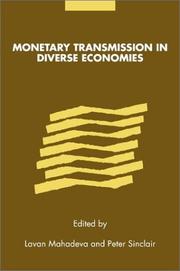
ISBN: 0521013259 0521813468 0511120443 0511042418 0511148240 0511330243 0511492480 1280159642 0511045492 1107133262 9780511120442 9780511042416 9780511492488 9780511045493 9780511148248 9786610159642 6610159645 9780521813464 9780521813464 9780521013253 Year: 2002 Publisher: Cambridge Cambridge University Press
Abstract | Keywords | Export | Availability | Bookmark
 Loading...
Loading...Choose an application
- Reference Manager
- EndNote
- RefWorks (Direct export to RefWorks)
This book was first published in 2002. The transmission mechanism of monetary policy explains how monetary policy works - which variables respond to interest rate changes, when, why, how, how much and how predictably. It is vital that central banks and their observers, worldwide, understand the transmission mechanism so that they know what monetary policy can do and what it should do to stabilize inflation and output. The volume sets out different aspects of the transmission mechanism. Some chapters scrutinize the relevance of practical issues such as asymmetries, recent structural changes and estimation errors using data on the USA, the Euro area and developing countries. Other chapters focus on modelling crucial aspects such as productivity, the exchange rate and the monetary sector. These issues are counterpointed by contributions that analyse monetary policy in Japan and the UK.
Banks and banking, Central. --- Monetary policy - Congresses. --- Business, Economy and Management --- Economics --- AA / International- internationaal --- 333.80 --- 333.846.0 --- NBB congres --- Banks and banking, Central --- -Capital movements --- -Monetary policy --- -Foreign exchange rates --- -339.53 --- Exchange rates --- Fixed exchange rates --- Flexible exchange rates --- Floating exchange rates --- Fluctuating exchange rates --- Foreign exchange --- Rates of exchange --- Monetary management --- Economic policy --- Currency boards --- Money supply --- Capital flight --- Capital flows --- Capital inflow --- Capital outflow --- Flight of capital --- Flow of capital --- Movements of capital --- Balance of payments --- International finance --- Banker's banks --- Banks, Central --- Central banking --- Central banks --- Banks and banking --- Geld-, bank- en kredietpolitiek. Kapitaalmarkt en -rente: algemeenheden. --- Verband tussen het monetair, bank- en kredietbeleid en de economische ontwikkeling: algemeenheden. --- Rates --- Conferences - Meetings --- Capital movements --- Monetary policy --- Foreign exchange rates --- 339.53 --- Geld-, bank- en kredietpolitiek. Kapitaalmarkt en -rente: algemeenheden --- Verband tussen het monetair, bank- en kredietbeleid en de economische ontwikkeling: algemeenheden
Book
ISBN: 9780674067851 0674067851 0674066871 0674071212 9780674066878 Year: 2013 Publisher: Cambridge, Mass. : Harvard University Press,
Abstract | Keywords | Export | Availability | Bookmark
 Loading...
Loading...Choose an application
- Reference Manager
- EndNote
- RefWorks (Direct export to RefWorks)
Robert Lucas is one of the outstanding monetary theorists of the past hundred years. Along with Knut Wicksell, Irving Fisher, John Maynard Keynes, James Tobin, and Milton Friedman (his teacher), Lucas revolutionized our understanding of how money interacts with the real economy of production, consumption, and exchange. Lucas's contributions are both methodological and substantive. Methodologically, he developed dynamic, stochastic, general equilibrium models to analyze economic decision-makers operating through time in a complex, probabilistic environment. Substantively, he incorporated the quantity theory of money into these models and derived its implications for money growth, inflation, and interest rates in the long run. He also showed the different effects of anticipated and unanticipated changes in the stock of money on economic fluctuations, and helped to demonstrate that there was not a long-run trade-off between unemployment and inflation (the Phillips curve) that policy-makers could exploit. The twenty-one papers collected in this volume fall primarily into three categories: core monetary theory and public finance, asset pricing, and the real effects of monetary instability. Published between 1972 and 2007, they will inspire students and researchers who want to study the work of a master of economic modeling and to advance economics as a pure and applied science.
Monetary policy. --- Money. --- BUSINESS & ECONOMICS / Economics / Macroeconomics --- POLITICAL SCIENCE / Economic Conditions --- Currency --- Monetary question --- Money, Primitive --- Specie --- Standard of value --- Exchange --- Finance --- Value --- Banks and banking --- Coinage --- Currency question --- Gold --- Silver --- Silver question --- Wealth --- Monetary management --- Economic policy --- Currency boards --- Money supply --- Lucas, Robert E. --- E-books --- Monetary policy --- Money --- Lucas, Robert E., --- Lucas, Robert --- 339.53 --- 331.031 --- 333.403 --- 333.80 --- AA / International- internationaal --- Louter monetaire theorieën i.v.m. conjunctuurschommelingen --- Monetaire theorieën. Kwantitatieve theorie. Theorie van de incasso's. Optiek van de uitgaven en inkomens --- Geld-, bank- en kredietpolitiek. Kapitaalmarkt en -rente: algemeenheden
Book
ISBN: 0691149097 0691162379 1400846579 1299051308 1400898951 9781400846573 9781299051300 9780691149097 9781400898954 Year: 2013 Publisher: Princeton : Princeton University Press,
Abstract | Keywords | Export | Availability | Bookmark
 Loading...
Loading...Choose an application
- Reference Manager
- EndNote
- RefWorks (Direct export to RefWorks)
When turmoil strikes world monetary and financial markets, leaders invariably call for 'a new Bretton Woods' to prevent catastrophic economic disorder and defuse political conflict. The name of the remote New Hampshire town where representatives of forty-four nations gathered in July 1944, in the midst of the century's second great war, has become shorthand for enlightened globalization. The actual story surrounding the historic Bretton Woods accords, however, is full of startling drama, intrigue, and rivalry, which are vividly brought to life in Benn Steil's epic account. Upending the conventional wisdom that Bretton Woods was the product of an amiable Anglo-American collaboration, Steil shows that it was in reality part of a much more ambitious geopolitical agenda hatched within President Franklin D. Roosevelt's Treasury and aimed at eliminating Britain as an economic and political rival. At the heart of the drama were the antipodal characters of John Maynard Keynes, the renowned and revolutionary British economist, and Harry Dexter White, the dogged, self-made American technocrat. Bringing to bear new and striking archival evidence, Steil offers the most compelling portrait yet of the complex and controversial figure of White--the architect of the dollar's privileged place in the Bretton Woods monetary system, who also, very privately, admired Soviet economic planning and engaged in clandestine communications with Soviet intelligence officials and agents over many years. A remarkably deft work of storytelling that reveals how the blueprint for the postwar economic order was actually drawn, The Battle of Bretton Woods is destined to become a classic of economic and political history.
International finance - History - 20th century. --- Keynes, John Maynard. --- Monetary policy - History - 20th century. --- White, Harry Dexter. --- Monetary policy --- International finance --- Finance --- Business & Economics --- Money --- 20th century --- History --- Keynes, John Maynard, --- White, Harry Dexter, --- United Nations Monetary and Financial Conference --- Monetary management --- Keĭns, Dzhon Maĭnard, --- Kʻai-yin-ssŭ, --- Kʻai-en-ssu, --- Keynes, J. M. --- Kenis, C. M., --- Keyns, C. M., --- Bretton Woods Conference --- Conférence monétaire et financière des Nations Unies, --- Conferencia Monetaria Internacional de Bretton-Woods --- Conferencia Monetaria y Financiera de las Naciones Unidos --- Monetary and Financial Conference, United Nations --- Rengōkoku Tsūka Kinʼyū Kaigi --- United Nations Monetary & Financial Conference --- United nations monetary and financial conference, --- Economic policy --- Currency boards --- Money supply --- 20th century. --- United Nations Monetary and Financial Conference. --- E-books --- -International finance --- -339.53 --- International monetary system --- International money --- International economic relations --- -History --- -Keynes, John Maynard --- Keynes, J. Maynard --- Keynes, J.M.
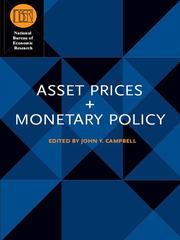
ISBN: 0226092119 9786611959296 1281959294 0226092127 9780226092126 6611959297 9780226092119 9781281959294 Year: 2008 Publisher: Chicago : University of Chicago Press,
Abstract | Keywords | Export | Availability | Bookmark
 Loading...
Loading...Choose an application
- Reference Manager
- EndNote
- RefWorks (Direct export to RefWorks)
Economic growth, low inflation, and financial stability are among the most important goals of policy makers, and central banks such as the Federal Reserve are key institutions for achieving these goals. In Asset Prices and Monetary Policy, leading scholars and practitioners probe the interaction of central banks, asset markets, and the general economy to forge a new understanding of the challenges facing policy makers as they manage an increasingly complex economic system. The contributors examine how central bankers determine their policy prescriptions with reference to the fluctuating housing market, the balance of debt and credit, changing beliefs of investors, the level of commodity prices, and other factors. At a time when the public has never been more involved in stocks, retirement funds, and real estate investment, this insightful book will be useful to all those concerned with the current state of the economy.
Capital assets pricing model. --- Capital investments. --- Investment analysis - Mathematics. --- Investment analysis -- Mathematics. --- Monetary policy. --- Securities - Prices. --- Securities -- Prices. --- Speculation. --- Monetary policy --- Securities --- Speculation --- Capital assets pricing model --- Investment analysis --- Capital investments --- Finance --- Business & Economics --- Money --- Prices --- Mathematics --- Prices. --- Mathematics. --- Capital expenditures --- Capital improvements --- Capital spending --- Fixed asset expenditures --- Plant and equipment investments --- Plant investments --- Analysis of investments --- Analysis of securities --- Security analysis --- Capital asset pricing model --- CAPM (Capital assets pricing model) --- Pricing model, Capital assets --- Bucket-shops --- Commercial corners --- Corners, Commercial --- Monetary management --- Investments --- Capital --- Gambling --- Commodity exchanges --- Contracts, Aleatory --- Stock exchanges --- Economic policy --- Currency boards --- Money supply --- Mathematical models --- E-books --- 339.53 --- 333.846.5 --- AA / International- internationaal --- Verband tussen de geld-, bank- en kredietpolitiek en de besparingen, kapitaalvorming, verdeling van vermogens --- economics, economy, growth, inflation, finances, financial, policy makers, central banks, federal reserve, asset markets, housing market, debt, credit, investors, commodity pricing, stocks, retirement funds, real estate, securities, prices, speculation, math, mathematics, investment, analysis, macroeconomics, expectations, learning, borrowing, exchange rate, monetary.
| Listing 1 - 8 of 8 |
Sort by
|

 Search
Search Feedback
Feedback About UniCat
About UniCat  Help
Help News
News